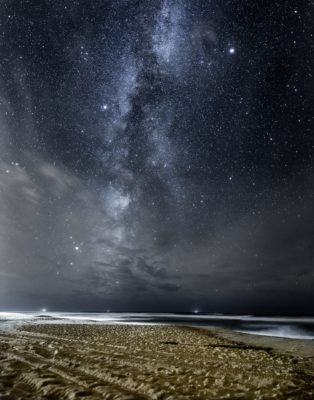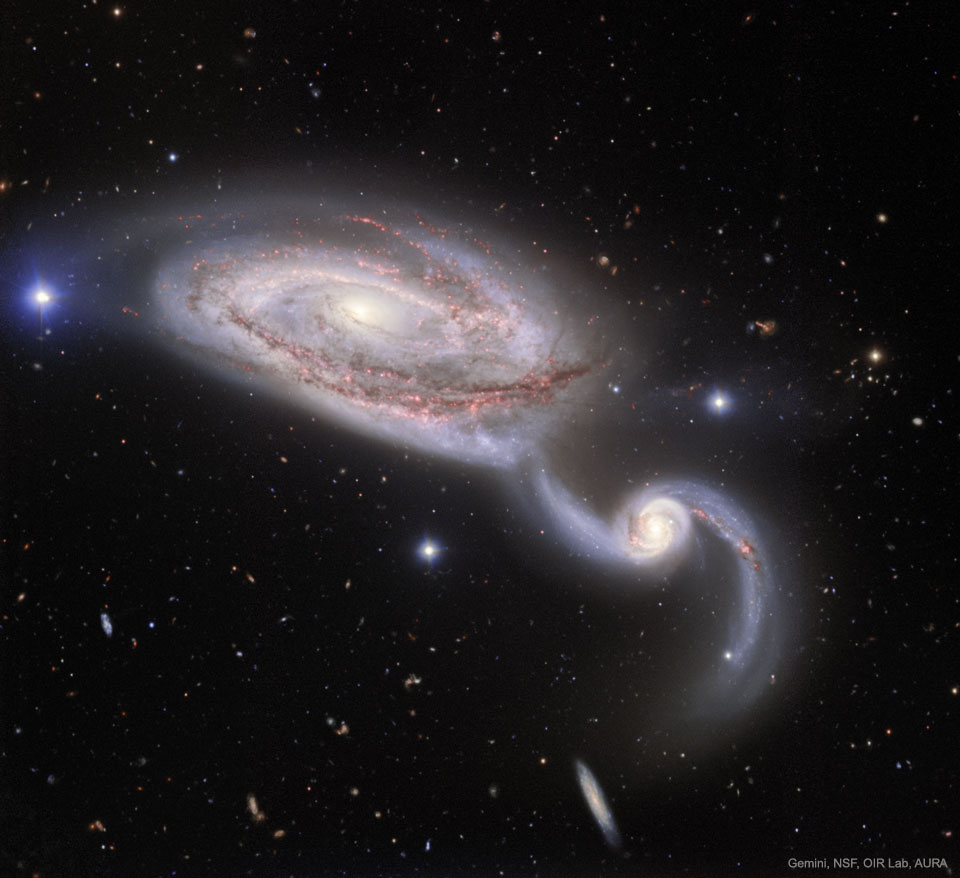Nombre total de pages vues
21/03/2020
11/03/2020
Science & Technology - Astronomy picture of the day : Moon Corona, Halo, and Arcs over Manitoba
2020 March 11
Image Credit & Copyright: Brent Mckean
Explanation:
Yes, but could you get to work on time if the Moon looked like this?
As the photographer was preparing to drive to work,
refraction,
reflection, and even
diffraction of moonlight from millions of falling ice crystals turned the
familiar icon of our Moon into a
menagerie of other-worldly halos and arcs.
The featured scene was captured with
three combined exposures two weeks ago on a cold winter morning in
Manitoba,
Canada.
The colorful rings
are a corona caused by
quantum diffraction
by small drops of water or ice near the direction of the
Moon.
Outside of that, a
22-degree halo
was created by moonlight refracting through six-sided cylindrical
ice crystals.
To the sides are
moon dogs, caused by light refracting through thin, flat,
six-sided ice platelets
as they flittered toward the ground.
Visible at the top and bottom of the
22-degree halo are upper and lower
tangent arcs,
created by moonlight refracting through nearly horizontal
hexagonal ice cylinders.
A few minutes later, from a field just off the road to work,
the halo and arcs had disappeared, the sky had returned to normal --
with the exception of a
single faint moon dog.
07/03/2020
Science & Technology - Astronomy picture of the day : Pic du Midi Panorama

Image Credit & Copyright: Patrick Lécureuil
Explanation:
A surreal night skyscape, this panorama stitched from 12 photos
looks to the west at an evening winter sky over
Pic du Midi
Observatory, Pyrenees Mountains, Planet Earth.
Telescope domes and a tall communications tower
inhabit the rugged foreground.
On the right,
lights from Tarbes, France about 35 kilometers away impinge on
the designated dark sky site though, but more distant
terrestrial lights
seen toward the left are from cities in Spain.
Stars and nebulae of the
northern winter's Milky Way
arc through the sky above.
Known to the planet's night skygazers,
the Pleiades and Hyades star clusters still hang over the western
horizon near center.
Captured in mid February the familiar stars of the
constellation Orion are to the left and include the
no longer
fainting star Betelgeuse.
04/03/2020
Science & Technologie - Stelvision : Le ciel du 4 Mars 2020 à 22h40 (centre France)
Repérez facilement les principales étoiles et planètes, et observez que tout le ciel semble tourner autour de l' étoile polaire ! Ainsi, les astres se lèvent et se couchent, et l'aspect du ciel change au long de la nuit...
Utilisation dehors : imprimez cette carte et placez-la au dessus de votre tête, le repère "Horizon NORD" vers le nord. Comparez au ciel observé !
Utilisation dehors : imprimez cette carte et placez-la au dessus de votre tête, le repère "Horizon NORD" vers le nord. Comparez au ciel observé !
à cause des mouvements des astres eux-mêmesLe Soleil, la Lune, les planètes, ont un mouvement perceptible au fil des jours (ou des semaines) par rapport au fond des étoiles. A l'inverse, les étoiles à l'extérieur de notre système solaire sont tellement lointaines qu'elles paraissent fixes au cours d'une vie humaine.
Science & Technology - Astronomy picture of the day : The Slow Dance of Galaxies NGC 5394 and 5395
Image Credit: Gemini, NSF, OIR Lab, AURA; Text: Ryan Tanner (NASA/USRA)
Explanation:
If you
like slow dances,
then this may be one for you.
A single turn in this dance takes
several hundred million years.
Two galaxies, NGC 5394 and NGC 5395,
slowly whirl about each other in a
gravitational interaction
that sets off a flourish of sparks in the form of new
stars.
The featured image, taken with the
Gemini North 8-meter telescope on
Maunakea,
Hawaii,
USA, combines
four different colors.
Emission from
hydrogen gas, colored red, marks
stellar nurseries where new stars drive the evolution of the
galaxies.
Also visible are dark
dust lanes that mark gas that will eventually become
stellar nurseries.
If you look carefully you will see
many more galaxies in
the background, some involved in their own slow
cosmic dances.
Science & Technologie - La Terre vue de l'Espace : Guiné Bissau
 La Guinée-Bissau est un petit pays en Afrique occidentale. Des différences sédimentaires complexes peuvent être vues dans les eaux peu profondes le long de son littoral, où la vase portée par le fleuve Geba et d'autres fleuves plonge dans l'océan Atlantique.
La Guinée-Bissau est un petit pays en Afrique occidentale. Des différences sédimentaires complexes peuvent être vues dans les eaux peu profondes le long de son littoral, où la vase portée par le fleuve Geba et d'autres fleuves plonge dans l'océan Atlantique.
© USGS, Nasa
03/03/2020
Science & Technologie - La Terre vue de l'Espace : Parc national de Canyonlands
 Le parc national de Canyonlands est situé dans l'Utah non loin de Moab (États-Unis). Cette image prise par Landsat 7 montre les trois principales parties du parc : Island in the Sky, the Needles et The Maze. Canyonlands offre un paysage minéral aride, façonné par l'érosion provoquée par le fleuve Colorado et la Green River dont les affluents ont creusé et sculpté la roche au cours de milliers d'années, laissant derrière eux des formes extraordinaires et un témoignage géologique unique.
Le parc national de Canyonlands est situé dans l'Utah non loin de Moab (États-Unis). Cette image prise par Landsat 7 montre les trois principales parties du parc : Island in the Sky, the Needles et The Maze. Canyonlands offre un paysage minéral aride, façonné par l'érosion provoquée par le fleuve Colorado et la Green River dont les affluents ont creusé et sculpté la roche au cours de milliers d'années, laissant derrière eux des formes extraordinaires et un témoignage géologique unique.© Nasa
02/03/2020
Science & Technology - Astronomy picture of the day : Sharpless-308: The Dolphin Nebula
2020 March 2

Sharpless-308: The Dolphin Nebula
Image Credit & Copyright: Chilesope 2, Pleaides Astrophotography Team (Peking U.)

Image Credit & Copyright: Chilesope 2, Pleaides Astrophotography Team (Peking U.)
Explanation:
Blown by fast winds from a hot, massive star, this
cosmic bubble is much larger than the dolphin it appears to be.
Cataloged as
Sharpless 2-308
it lies some 5,200 light-years away toward the constellation of
the Big Dog
(Canis Major)
and covers slightly more of the sky than a
Full Moon.
That corresponds to a diameter of 60
light-years at its estimated distance.
The massive star that created the bubble, a
Wolf-Rayet
star, is the bright one near the center of the nebula.
Wolf-Rayet
stars have over 20 times the mass of the
Sun and are thought to be in a brief,
pre-supernova phase of massive
star evolution.
Fast winds from this
Wolf-Rayet
star create the bubble-shaped nebula as they
sweep up slower moving material from an earlier phase of evolution.
The windblown nebula has an age of about
70,000
years.
Relatively faint emission captured in the
featured expansive image
is dominated by the glow of ionized oxygen atoms
mapped to a blue hue.
01/03/2020
Science & Technology - Astronomy picture of the day : A hole in Mars
Image Credit: NASA, JPL, U. Arizona
Explanation:
What created this unusual hole in Mars?
The hole was discovered by chance in 2011 on images of the dusty slopes of Mars'
Pavonis Mons volcano taken by the
HiRISE instrument aboard the robotic
Mars Reconnaissance Orbiter currently circling Mars.
The hole, shown in representative color, appears to be an opening to an underground cavern, partly illuminated on the image right.
Analysis of this and follow-up images revealed the
opening to be about 35 meters across, while the interior
shadow angle indicates that the underlying cavern is roughly 20 meters deep.
Why there is a circular crater surrounding this hole remains a topic of
speculation,
as is the full extent of the underlying cavern.
Holes such as
this are of particular interest because their interior caves are relatively protected from the harsh surface of
Mars,
making them relatively good candidates to
contain Martian life.
These pits are therefore prime targets for
possible future spacecraft, robots, and even
human interplanetary explorers.
09/02/2020
Science & Technologie - Astronomy icture of the day : To Fly Free in Space

Explanation: What would it be like to fly free in space? At about 100 meters from the cargo bay of the space shuttle Challenger, Bruce McCandless II was living the dream -- floating farther out than anyone had ever been before. Guided by a Manned Maneuvering Unit (MMU), astronaut McCandless, pictured, was floating free in space. McCandless and fellow NASA astronaut Robert Stewart were the first to experience such an "untethered space walk" during Space Shuttle mission 41-B in1984. The MMU worked by shooting jets of nitrogen and was used to help deploy and retrieve satellites. With a mass over 140 kilograms, an MMU is heavy on Earth, but, like everything, is weightless when drifting in orbit. The MMU was later replaced with the SAFER backpack propulsion unit.
Inscription à :
Articles (Atom)
SANTé/MEDECINE - La grossesse mois par mois - 5ème mois
Le fœtus à 5 mois de grossesse C'est le moment où la future maman sent bouger et gigoter le fœtus qui, lui, perçoit les caresses. Un fi...

-
2022 September 26 All the Water on Planet Earth Illustration Credit: Jack Cook, Adam Nieman, Woods Hole Oceanographic Institution ; Data ...
-
2021 August 11 Mammatus Clouds over Saskatchewan Image Credit & Copyright: Michael F Johnston Explanation: When do cloud bottoms appe...



